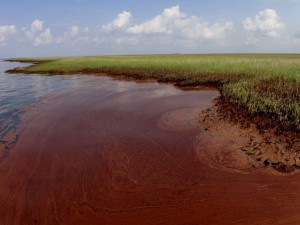To be honest I don’t really want to think about these possibilities too much, since they translate to an unstoppable blowout, a worst case scenario where relief wells cannot stop the flow. This is from today’s theOilDrum.com Deepwater Oil Spill – A Longer Term Problem, Personnel – and Open Thread thread.
Latest numbers I’ve seen for the recoverable (what they can pull up that is) reservoir size is about 100 to 150 million barrels (that’s about 5-7.5 days total US consumption to put it into perspective). This is what we are doing to keep driving…
Prof. Goose on June 12, 2010 – 11:25am Permalink | Subthread | Comments top
“BP Official (Hofmeister) [sic: Hofmeister is an ex Shell Oil Official, not BP!] Admits to Damage Beneath the Sea Floor” (a bit of informed conjecture…)
Washington Post – BP oil spill
Yesterday, recently-retired Shell Oil President John Hofmeister said that the well casing below the sea floor may have been compromised:
[Question] What are the chances that the well casing below the sea floor has been compromised, and that gas and oil are coming up the outside of the well casing, eroding the surrounding soft rock. Could this lead to a catastrophic geological failure, unstoppable even by the relief wells?
John Hofmeister: This is what some people fear has occurred. It is also why the “top kill” process was halted. If the casing is compromised the well is that much more difficult to shut down, including the risk that the relief wells may not be enough. If the relief wells do not result in stopping the flow, the next and drastic step is to implode the well on top of itself, which carries other risks as well.
theengineer.co.uk – BP now capturing 16k barrels/day at Deepwater Horizon
(more…)
